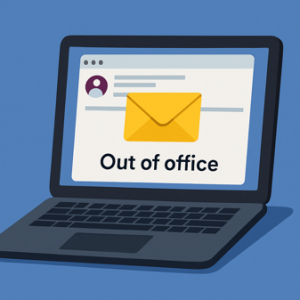
You’re off to a well-earned vacation. Bags are packed, inbox is set with a friendly “back soon” auto-reply. But while you’re sipping a Spotted Cow at a lakeside cabin, a hacker might be using your message to launch a Business Email Compromise (BEC) attack.
Sounds dramatic? It’s not. It’s happening. And small businesses across Milwaukee are more exposed than they think.
What Is Business Email Compromise—and What’s It Got to Do with OOO Messages?
BEC is when a cybercriminal impersonates someone inside your company—often an executive, manager, or vendor—and tricks others into sending money, sharing data, or opening malicious files.
And one of their easiest tools? Your Out-of-Office message.
Why? Because that automated message usually includes:
- Your name and title (check)
- Who’s covering for you (check)
- Your schedule or when you’ll be back (check)
- Your tone, writing style, and a few real-life details (check)
With that intel, it’s incredibly easy for a scammer to send a convincing email to your team saying, “Hey, while I’m out, can you wire $12K to this vendor? Here’s the invoice.”
It’s timely, personal, and sounds exactly like something you'd say.
Real-World Example: How It Goes Down
Let’s say your OOO message says:
“I’m out of the office July 15–19 for a family vacation. For urgent needs, reach out to Sara at sara@yourbiz.com.”
Now the attacker knows:
- You’re unavailable to verify anything
- Who they can impersonate next (Sara)
- When to strike
Next thing you know, Sara gets an email from “you” saying, “Can you handle this invoice while I’m out?” Only it’s not from you—it’s from a spoofed address.
Now $42,000 is wired to a fake account before you even get home.
So, What Can You Do?
Here’s how to outsmart the phishers and keep your team protected—even while you’re offline.
- Keep OOO Messages Vague (Internally Detailed, Externally Guarded)
Use different messages for internal and external contacts. Your colleagues might need backup details—but strangers don’t.
Public OOO Example:
“I’m currently unavailable but will respond as soon as possible upon my return.”
Internal OOO Example:
“I’m out July 15–19. For urgent issues, contact Sara in Accounting.”
- Set Email Spoofing Protections
Talk to your IT provider about DMARC, SPF, and DKIM settings. These protocols help prevent email spoofing and impersonation.
- Use MFA Everywhere
Multifactor authentication (MFA) should be enabled across all e-mail accounts. Even if a hacker obtains a password, it prevents them from gaining access.
- Train Your Team to Spot Suspicious Timing
If a financial or sensitive request comes while someone is out of office—that’s a red flag.
- Create a “No Wires Without Voice” Rule
Make it standard that no financial transaction over a certain amount happens without a verbal confirmation—no exceptions.
- Work with an IT Partner who Monitors Activity
A proactive IT and cybersecurity partner can detect login attempts, phishing attacks and abnormal behavior before damage is done.
Milwaukee IT Support Tip: It’s not paranoia-IT’s Preparedness
Attacks can start with something as simple as an auto-reply. Hackers don’t need to breach your firewall—just a little info from your out-of-office message can be all they need to exploit your business.At PC LAN Services, we help Milwaukee small businesses protect against evolving cybersecurity threats. If you're looking for trusted IT services in Milwaukee, we can help secure your systems—starting with smart email practices.
Looking for expert IT support for small businesses in Milwaukee? Let’s talk: wwwpclan.com/discoverycall



